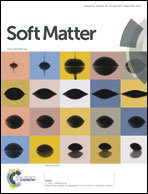Effect of local chain deformability on the temperature-induced morphological transitions of polystyrene-b-poly(N-isopropylacrylamide) micelles in aqueous solution†
Abstract
The effect of temperature on the micellar morphology of two polystyrene-b-poly(N-isopropylacrylamide) (PS-b-PNIPAM) diblock copolymers in an aqueous solution was investigated by dynamic light scattering (DLS) and transmission electron microscopy (TEM). At 25 °C, a mixture of vesicles and spheres are observed for the micelles of PS65-b-PNIPAM108, while PS65-b-PNIPAM360 exhibits mixed cylindrical and spherical micellar morphology. Upon increasing the temperature, the micellar morphology becomes spherical for PS65-b-PNIPAM108 at 60 °C and for PS65-b-PNIPAM360 at 40 °C. Such vesicle-to-sphere and cylinder-to-sphere transitions of micellar morphology are reversible when the micellar solutions are cooled back to 25 °C. However, these temperature-induced morphological transitions of the PS-b-PNIPAM micelles are contrary to the theoretical prediction. Qualitative analysis of the free energy shows that vesicular or cylindrical micelles tend to form at higher temperatures if only the overall volume change of the PNIPAM block is considered. The contradiction between the experimental results and theoretical prediction is interpreted in terms of the local deformability of the PNIPAM chains. At elevated temperatures, the collapsed PNIPAM globules are less deformable and must occupy larger areas at the micellar interface, although the overall volume is smaller at higher temperatures. This will lead to a larger repulsion between the PNIPAM globules and a remarkable increase in the free energy of the corona; thus, the formation of vesicles or cylinders at higher temperatures is prohibited.


 Please wait while we load your content...
Please wait while we load your content...